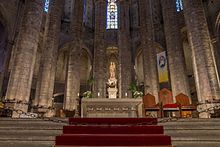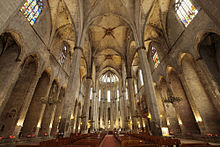Santa Maria del Mar
Santa Maria del Mar is a Gothic church in Barcelona , Spain . It is located in the La Ribera district and was built between 1329 and 1383, during the heyday of Catalan supremacy in trade and at sea. It is an outstanding example of Catalan Gothic , with a purity and uniformity of style that is otherwise unusual for large medieval buildings.
history
Legend has it that the apostle James preached on the spot where the church stands today, which prompted the building of a small chapel. The name of the chapel was "Santa Maria de Les Arenes". Saint Eulalia of Barcelona was buried there around 304, but her body was later transferred to La Catedral .
The first written mention of a church of Santa Maria by the sea comes from the year 998. The construction of the current building was promoted by Canon Bernat Llull, who was appointed Archdean of Santa Maria in 1324. The construction of the current church began on March 25, 1329 with the laying of the foundation stone by King Alfonso IV , as evidenced by a plaque in Latin and Catalan that was attached to the facade of the Fossar de les Moreres . The architects in charge were Berenguer de Montagut, who designed the building, and Ramon Despuig. All guilds in the Ribera district were involved during the construction period . The porters in particular made a large voluntary contribution, their commitment was praised on a small bronze plaque on the main portal. The walls, side chapels and facades were completed in 1350. In 1379 a fire destroyed important parts of the building. Finally, on November 3, 1383, the last stone was set, and on August 15, 1383, the first mass was read.
On February 2nd, 1428 an earthquake caused severe damage and destroyed the rose window in the west facade. The new flamboyant-style window was completed in 1459, and the glass was added a year later.
1923 the church by Pope Pius XI. the title Basilica minor bestowed. The pictures and the baroque altar were destroyed at the beginning of the Spanish Civil War by anti-church groups on July 19 and 20, 1936. The sacrament chapel was added to the apse in the 19th century .
architecture
Exterior view
Santa Maria del Mar is enclosed by the narrow streets of Ribera, which makes it difficult to get an overall impression of the building from the outside. This is most likely from the Fossar de les Moreres and Plaça de Santa Maria, both of which used to be cemeteries. The west facade gives the impression of compactness and sober rigor that is typical of the Catalan Gothic . It is clearly divided into three sections by two tall buttresses, which correspond to the three naves. Pictures of St. Peter and St. Paul occupy the niches on both sides of the west portal. The tympanum shows Jesus, flanked by Mary and John. The slim, octagonal northwest tower was completed in 1496, its counterpart remained unfinished until 1902.
inner space

In contrast to the west facade, the interior gives the impression of spaciousness. It corresponds to the basilica type, with three naves that form a single room without transepts . There is no architectural limit between the nave and the presbytery . In this church building, the bundling of the vault load on a few points was new, so that the simple ribbed vault of the main nave is supported by just four slim, octagonal columns. It spanned the enormous width of 13 meters for the time. Also unusual for a cathedral of this time is the very filigree, elegant-looking pillar wreath that surrounds the apse.
Due to a fire during the rioting against the church in 1936, there are hardly any works of art in the interior. Among the most notable works destroyed by the fire was the baroque altarpiece by Deodat Casanoves and Salvador Gurri. Of the original windows, only the depictions of the Ascension and the washing of the feet, as well as some geometric motifs in the apse, have survived.
organ
The organ is a historical instrument that was restored by the organ builder Grenzing . The instrument has 21 stops on two manuals and a pedal .
|
|
|
|
|||||||||||||||||||||||||||||||||||||||||||||||||||||||||||||||||||||||||||||
- Subsidiary registers: Rossinyol, Tambor, Gaita
- Remarks:
- (B) = bass side
- (D) = treble side
Santa Maria del Mar in literature
The building of Santa Maria del Mar forms the background in the novel The Cathedral of the Sea by Ildefonso Falcones . This book, published at the end of 2006 under the original title La Catedral del Mar , developed into a bestseller in Spain and was also published in German in December 2007.
Individual evidence
- ↑ a b c d e Cirici, Alexandre. Barcelona paso a paso , Barcelona, Editorial Teide, SA 2nd ed., 1981
- ↑ "Santa Maria de Les Arenes" chapel. Retrieved May 5, 2020 .
- ↑ a b Veronika Schroeder, Barcelona, Munich 2011, p. 49
- ↑ a b c d Hernàndez-Cros, Josep Emili (ed.). Catàleg del Patrimoni Arquitectònic Històrico-Artístic de la Ciutat de Barcelona , Barcelona, Ajuntament de Barcelona, 1987
- ↑ a b c Veronika Schroeder, Barcelona, Munich 2011, p. 50
- ↑ More information about the organ
Web links
Coordinates: 41 ° 23 ′ 1.4 " N , 2 ° 10 ′ 55.3" E














